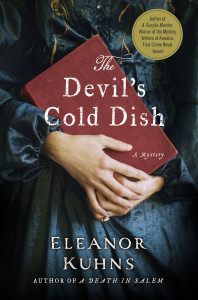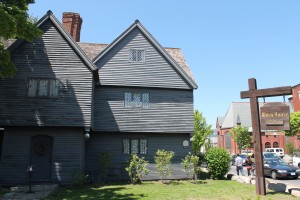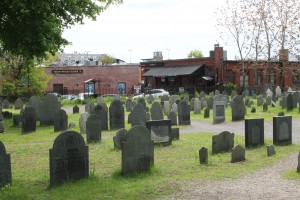Very excited to announce I will be at the Elm Street Bookstore in New Canaan, Ct on Saturday, September 9 from 12 noon to 2:30. I expect to talk about witchcraft as well as the Shakers and will bring some show and tell items.
Tag Archives: witchcraft
Devil’s Cold Dish – contracts and edits
I am happy to announce that I received both the contracts and the edits for the Devil’s Cold Dish.
The contracts have been signed and put in the mail.
I am still working on the edits but they are almost done. These are line edits; i.e. the editor goes over the manuscript and comments/questions items. This is when the editor has the author correct the manuscript – are there too many repetitions of the same information? Does the plot need some changes? Too many characters?
I enjoy this part of the editing because it makes me think of the manuscript and the story in a new way. Confusing sections are clarified and sometimes I take the opportunity to expand on something. this is my chance to look at the story with fresh eyes – for good or ill since I can either think this book is good or terrible.
The next time I see the manuscript I will be working on copy edits which I don’t like at all. This is grammatical mistakes, any double periods I haven’t caught. If I haven’t paid close enough attention to the time line, I can be sure the copy editor will pick it up.
Witches and witchcraft – beyond Salem
Although I don’t address witchcraft of the trials in Death in Salem, I write about a period 100 years later, I do use it in The Devil’s Cold Dish.I am fascinated by the persistent belief in witches. Although the trials ended before 1700 and reparations began to be paid to surviving victims and families of the executed, belief in witches and the trials did not end then. As I have written in other posts, belief – and accusations – continued well into the 1800’s. ( And actually into modern times ). With Halloween only days away, it seems appropriate to address the topic again. The craze in Massacheusetts came after several centuries of the trials and burnings in Europe. Belief in magic was widespread. Girls used spells to try and see the faces of future husbands and superstitions regarding illness, birth, harvest were rife. Harelips were caused when the mother saw a rabbit, birth marks because the mother ate strawberries, for example. One of my favorites: to protect a mother and child during birth put an ear of corn on the mother’s belly. Reasons given for the explosion of belief and hangings in Salem are many. I just read several pieces on Tituba. Variously described as an Indian or a black slave, her testimony apparently drove much of the content of the stories and was a direct cause of the eventual hangings of women described as her confederates. (Although they all protested their innocence, sixteen were hanged. Tituba was set free.) A shadowy character, she has been also described as practicing voodoo. Her testimony. at least to me, reads more like the Christian belief in demons and the devil. Once she was released, however, she, like the girls whose fits started the terror, faded into obscurity. By the late eighteen hundreds her name was used to frighten children and she is shown in illustrations in the witches’s black dress holding her broom. Considering the amazing staying power of accusations, one has to wonder about the psychology behind these beliefs. Of course malice plays a huge role as does mysogyny. But why the belief in evil supernatural powers and submission to the Devil? I still have trouble wrapping my mind around it.
Devil’s Cold Dish
I am happy and so excited to announce that I have received the cover for the new Will Rees mystery – A Devil’s Cold Dish. The graphics arts department at Minotaur is so good. In my opinion, they have scored with every single cover.
Will and Lydia Rees return to Dugard after their adventures in Salem and find themselves in new trouble. Not only is Will accused of murder but Lydia finds her own life in danger.
Coming June, 2016
Witches – Salem and more
I ‘ve had a couple of questions about my most recent book, Death in Salem. Why didn’t I fully explore the witchcraft angle? Well, as I’ve said in earlier posts, Salem by 1797, was a very cosmopolitan city. It was not only the sixth largest, one of the most diverse (with the first East Indian immigrant populations in the US) but it was also the wealthiest. Salem’s witchcraft past was more an embarrassment.
House of one of the judges.
The witchcraft spell has never completely left Salem, however. On one of our tours, the guide was the descendent of one of the accused witches. Reminders of this past abound.
Graveyard includes memorials to those that were executed.
Although Salem became something other – a huge center of shipping and trading, however, the belief in witchcraft did not fade. In an earlier blog I wrote about trials that continued, right up to one in Russia in 1999.
And I wonder what is behind these accusations? Belief? Greed, malice, revenge? Hatred of women. With Gamer gate and all of the Internet attacks on women we certainly cannot discount that as a motive.
Christianity certainly plays a part.I think most of us are familiar with the quote from the Bible about not suffering a witch to live. During the middle ages and right up to modern times this has been used to execute any number of innocent people, primarily women.
I will blog in the future about my research into witchcraft and goddesses – I think the two are tied. I decided, that since I did not explore witchcraft and the psychologies behind it in Death in Salem, I would do so in the next book. That book, titled The Devil”s Cold Dish, will be coming out next year. Spoiler alert: it does not take place in Salem.
Death in Salem books
I am thrilled to announce that I have received my first copies of Death in Salem and they look stunning. Here is the cover:
The books look even better in real life. I will probably be having another Goodreads giveaway later in the summer.
To summarize the plot: Will Rees is on a weaving trip and stops in Salem to buy some imported cloth for Lydia. He gets stopped by a funeral and sees an old friend at the head. Anstiss Boothe, the deceased, has been ill a long time but the very next day her husband Jacob. a wealthy Salem merchant, is dead and this time it is clearly murder. Rees has already left Salem but his friend rides after him and draws him back to investigate.
Smuggling, piracy, prostitution, and of course all the dynamics of interpersonal relationships keep Rees investigating.
I had a lot of fun roaming Salem when I researched this book.
Death in Salem Goodreads Giveaway
Well, I’m excited. After the first day of the giveaway, almost 200 people requested the book. Fantastic!
Tarot and circuses
Why am I interested in tarot? These cards have been around since the mid 1500s. They were used as playing cards and like our deck, they had suits.
But aren’t they used for divination? That is certainly what I was most familiar with them as. Certainly, their use for that purpose is documented from about 1540. Manuscripts from shortly after document a system for laying out the cards. According to Wikipedia “Giacomo Cassanova wrote in his diary that in 1765 his Russian mistress frequently used a deck of playing cards for divination
Antoine Court de Gébelin, a French-born Protestant pastor and Freemason, published a dissertation on the origins of the symbolism in the Tarot in volume VIII of his unfinished fifteen volumes of the Le Monde Primitif. De Gébelin, who never knew the Tarot as the thought the Tarot represented Egyptian theology including Isis and Osiris. For example, he thought the card he knew as the Papesse and known today as the high priestess represented Isis.
The 1700s saw a rebirth of the circus.
I say rebirth because the kind of performances one thinks of have a long long history. The Egyptians had a tradition of acrobatics and juggling and they passed that onto the Greeks and the Romans. And these itinerant performers, called funanbuli – literally rope dancers – traveled throughout the expansive empire. During the middle ages, all the fairs boasted performers: jugglers and the like.
But all of this ceased in Great Britain and then in the new country with the Puritans who thought performances of all kinds were works of the Devil. Theaters in New England were forbidden right up until the late 1700’s. But in Europe traveling performers continued. In 1768 Sergeant-Major Philip Astley began exhibiing his equestrian prowess outside of London. Other equestrian acts followed. He called it a ‘circus’, the Latin word for circle because the riders rode around a ring. He struck gold. In 1779 he built a riding school. His ampitheater became the model for circuses everywhere.
At first these circuses were primarily exhibitions of trick riding but gradually acrobats, jugglers, rope dancers – tightrope walkers – were added. Family dynasties of circus performers were born.
A pupil of his, John Bill Ricketts, brought the circus to America. He first began a riding school in Philadelphia in 1792. It was wildly successful; people were hungry for entertainment. By 1793 he had begun bringing over European performers – including acrobats, clowns and rope dancers.
Other entrepreneurs followed suit, including a farmer from Brewster, New York , who found an elephant somewhere and brought it on tour. The display of exotic animals had been popular as early as the Bronze Age but this was a first in the U.S. Animal acts, primarily using dogs and pigs, followed.
Since tarot had been popular in Europe for centuries and had been used almost as long for divination, I wonder if some of these early circus performers didn’t bring the cards with them. Tarot would have predated the stereotypical circus fortune teller with the glass ball.
Now, with our jaded sensibilities, it is hard to imagine how exotic and wonderful these early circuses appeared. Farmers knew horses but not ones who allowed riders to stand on their backs. Pigs and dogs, animals they saw every day, performed the most amazing tricks. And any fortune telling would have seemed truly magical.
Midwifery – and Witchcraft?
As Lydia, one of the principle characters (married to my detective Will Rees) prepares to deliver their first baby, my thoughts turned to births. In that time both maternal and infant mortality was high. It was not uncommon for a man to be buried in a church yard with several wives.
Most women, especially those in the country, had their babies delivered by a midwife. For one thing, it was considered indecent for a man to witness the birth. Male physicians were just beginning to make inroads in delivering babies in the cities. Thousands of women who were burned in Europe as witches were midwives and healers . Why? Well. everyone knew women, who were ill-educated to begin with, were too stupid to learn something like this so the knowledge had to have a supernatural origin, i.e. the Devil. This in spite of the fact that midwives have been part of human history for millennia and there were less deaths when midwives delivered the babies. They washed their hands. Male doctors, according to the history I’ve read, did not and they passed bacteria from one woman to another, with maternal death following.
What did midwives do? Think about this: there were no pain killers other than alcohol and opium and anyway it was thought women should suffer. After all, they were guilty of listening to the serpent in the Garden of Eden and persuading Adam to eat the forbidden apple. Queen Victoria popularized pain killers during birth. (Smart woman).
There were no stethoscopes. They were not invented until 1816 and then looked like a long tube. Forceps were invented centuries earlier but were risky. Obstetric tools discovered in 1813 included forceps used by a male physician so they were known and used by then.
But midwives helped with the breathing, cut the cord, and some experienced midwives could turn a baby who was in a breech position. After the birth, they cleaned the baby, removing the mucous from nose and mouth, and made sure the cry was robust. Usually the midwife had an apprentice or two.
Now, with an interest in ‘natural birth’, we have come full circle back to midwives.
Witch Hunts after Salem
Although the witch craze in Salem ended, with many consequences as I have mentioned in an earlier post, the belief in witches did not end. With an increasing interest and belief in science, a belief in witches faded but did not disappear, either in Europe or in the Colonies – new United States. Legally, a witch trial and a judicial solution to perceived witch craft became unlikely (and I imagine that the uncritical acceptance of spectral evidence by Samuel Parris in Salem had a lot to do with increasing skepticism) hanging by lynch mobs could still happen.
In Europe women were still attacked and in some cases executed for witchcraft. In Denmanrk (1800), in Poland in 1836 and even in Britain in 1863. Violence continued in France through the 1830’s. And in the United States, as previously mentioned, Ann Lee of the Shakers was arrested and charged for blasphemy in 1783. But she was released.
In the 1830s a prosecution was begun against a man (yes) in Tennessee. Even as recently as 1997 two Russian farmers killed a woman and injured members of her family for the use of folk magic against them.
Why am I blogging about witchcraft? Well, one of the comments about one of my earlier posts talked about the influence of one person in swaying a community to hunting a witch. No matter how you look at it, most of the motivations behind witch hunts show the worst of human nature. Readings I’ve done point to class warfare and gender conflict. And while it is true that in some European countries men have been accused, in most of Europe and the United States the ones hunted have been women. There are a variety of opinions: control of a woman’s sexuality for one. The control of women’s reproductive life (and the eradication of midwives) for another. Considering what is still happening here I believe it. But some of the other motivations are equally as unflattering: greed, malice, revenge.
With all of this bouncing around in my head, I’ve decided that my next Will Rees (after Death in Salem) will look at some of these themes. You heard it here first.





